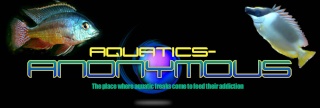[You must be registered and logged in to see this image.]
Otto Cats/Otocinclus vestitus
A great algae eater for small tanks, an otto catfish is a great addition to any small tropical tank. They will not harm any other fish like a SAE and their bio-load is relatively small. These fish are best kept in groups of three or more, because they do get lonely. They are low profile fish spending most of their time swimming, and have a gray and black coloring. When under stress these fish will appear washed out, but they usually color up within a day or two of improved conditions.
These fish are delicate, and should be moved from tank to tank carefully, or else you have a higher chance of the fish dying in the next four weeks.
Ottos have been known to reproduce in a tank, but you are more likely to see the babies then the eggs, and it is pretty rare that you get the babies. They grow to be about an inch to an inch and a half in length when full grown, and they can only be sexed by the size, where males are generally smaller then the females.
Otto cats are primarily herbivores so you will need to supplement the Otocinclus diet with algae wafers if you think they may not be getting enough algae to eat. Some people have difficulty in keeping them and it may stem from the tank not having enough algae present for grazing, improper acclimation, lack of hiding places, high nitrates and low oxygen levels.
Otocinclus Care Level : Easy but needs to be slowly acclimated and you must keep them in optimum water conditions by performing frequent partial water changes. Only add them to tanks that have completed the aquarium nitrogen cycle.
When buying look for the fish with the pinkest belly, for they are the most likely to survive the move.
Size : Up to 2 inches (5 cm)
pH : 6 - 7.5
Temperature : 70°F - 78°F (21°C - 26°C)
Water Hardness : 6° to 15° dH
Lifespan : 3 - 5 years
Temperament / Behavior : This is a very peaceful catfish and does well when kept in small schools.
Breeding / Mating / Reproduction : They can be difficult to breed in the home aquarium. They will lay eggs on plant leaves.
Tank Size : 10 gallon or larger.
Compatible Tank Mates : Many, given their peaceful nature. Avoid keeping with fish large enough to eat them and fish that are overly aggressive.
Diet / Fish Food : Herbivores, you may need to supplement their diet with algae wafers.
Tank Region : Mostly middle to top.
Otto Cats/Otocinclus vestitus
A great algae eater for small tanks, an otto catfish is a great addition to any small tropical tank. They will not harm any other fish like a SAE and their bio-load is relatively small. These fish are best kept in groups of three or more, because they do get lonely. They are low profile fish spending most of their time swimming, and have a gray and black coloring. When under stress these fish will appear washed out, but they usually color up within a day or two of improved conditions.
These fish are delicate, and should be moved from tank to tank carefully, or else you have a higher chance of the fish dying in the next four weeks.
Ottos have been known to reproduce in a tank, but you are more likely to see the babies then the eggs, and it is pretty rare that you get the babies. They grow to be about an inch to an inch and a half in length when full grown, and they can only be sexed by the size, where males are generally smaller then the females.
Otto cats are primarily herbivores so you will need to supplement the Otocinclus diet with algae wafers if you think they may not be getting enough algae to eat. Some people have difficulty in keeping them and it may stem from the tank not having enough algae present for grazing, improper acclimation, lack of hiding places, high nitrates and low oxygen levels.
Otocinclus Care Level : Easy but needs to be slowly acclimated and you must keep them in optimum water conditions by performing frequent partial water changes. Only add them to tanks that have completed the aquarium nitrogen cycle.
When buying look for the fish with the pinkest belly, for they are the most likely to survive the move.
Size : Up to 2 inches (5 cm)
pH : 6 - 7.5
Temperature : 70°F - 78°F (21°C - 26°C)
Water Hardness : 6° to 15° dH
Lifespan : 3 - 5 years
Temperament / Behavior : This is a very peaceful catfish and does well when kept in small schools.
Breeding / Mating / Reproduction : They can be difficult to breed in the home aquarium. They will lay eggs on plant leaves.
Tank Size : 10 gallon or larger.
Compatible Tank Mates : Many, given their peaceful nature. Avoid keeping with fish large enough to eat them and fish that are overly aggressive.
Diet / Fish Food : Herbivores, you may need to supplement their diet with algae wafers.
Tank Region : Mostly middle to top.



